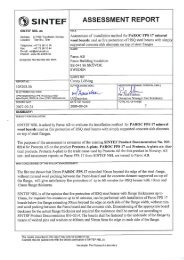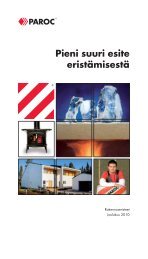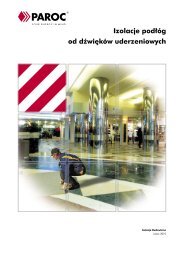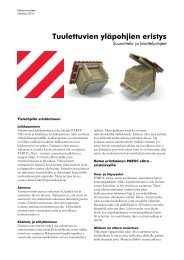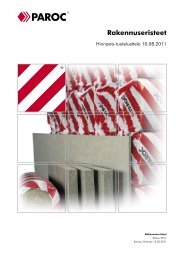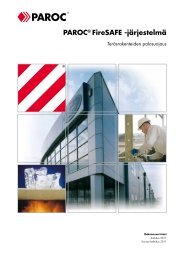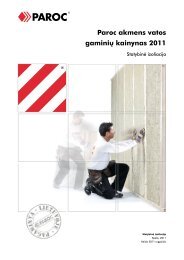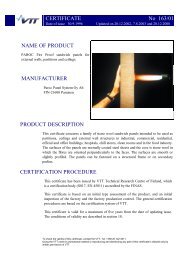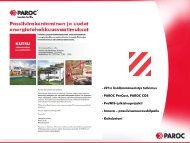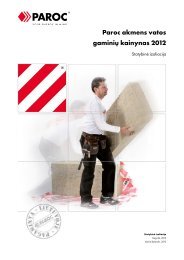Impact Sound Insulation - Paroc.com
Impact Sound Insulation - Paroc.com
Impact Sound Insulation - Paroc.com
- No tags were found...
Create successful ePaper yourself
Turn your PDF publications into a flip-book with our unique Google optimized e-Paper software.
<strong>Impact</strong> <strong>Sound</strong> <strong>Insulation</strong>Building <strong>Insulation</strong>December 2004
IMPACT SOUND INSULATIONContentsWorld of Steps ...................................... 3Demands regarding sound in buildings . 4Why Choose <strong>Paroc</strong> Stone Wool ............. 6Dimensioning, General ......................... 8Concrete Floors .................................. 10Wooden Floors ................................... 12Solutions, <strong>Impact</strong> <strong>Sound</strong>...................... 14Comments to Solutions ........................ 16Product Information ............................ 17General Working Instructions .............. 182
IMPACT SOUND INSULATIONWorld of StepsComfortThe need of privacy and <strong>com</strong>fort inour homes be<strong>com</strong>es bigger and biggerdue to the fact of the noisieratmosphere surrounding us.<strong>Paroc</strong> stone wool is very useful inconnection to this by making moresound reducing constructions. Stonewool is used in floors to reduce theimpact or step sound from flats above.But may also be used in walls toreduce noise from your neighbour orfrom outside.This brochure is about impactsound and how to make our livingmore <strong>com</strong>fortable by good floorsolutions.NeedsThe needs regarding impact soundinsulation have increased during thelast years. New machines and loudsound reproduction equipment havecaused an increased need forconstructions with high soundinsulation. Modern machines arefurthermore <strong>com</strong>paratively strong inthe low frequency region, whichmeans that low frequency noise issuesin buildings is be<strong>com</strong>ing moreimportant.RegulationsNormally the regulations are dividedinto classes where the basic demandeasily can be upgraded by the use of a<strong>Paroc</strong> stone wool step sound board inthe construction. The aim of thisbrochure is to inform about theconnection between product choiceand resulting sound insulation and topresent how to design buildingsaccording to the requirements.The technical demands are allcovered by the EN regulations, whichmean that the requirements arereferring to the same standards all overEurope. The science, buildingacoustics, as such is relatively new whythe test methods and also demandswere relatively harmonised also beforethe EN regulations.Concrete or wooden structureThe standards allow calculation of theresults for a construction when thebasic properties for the material areknown, especially regardingmonolithic floors made of concrete.Wooden floors are more <strong>com</strong>plex andthe sound insulation depends on thelayers and the layer structure, thethickness and weight etc. Woodenfloors have to be individually designedand probably also measured to get anaccurate result.Added demandsIn some countries the demands alsoincludes an adoption term called theC-term. Demands and measurementresults with the C-terms included aremore fair when <strong>com</strong>paringconstructions. It is however moredifficult to make accuratemeasurements at low frequencies.Normally the C-term means that theconstruction gets a lower value of 0-3dB for both air borne and for impactsound, but for constructions intendedfor high sound insulation thedifference can be much larger.Re<strong>com</strong>mendationsThe idea of this brochure is tointroduce solutions, with <strong>Paroc</strong> stonewool, that meet the local nationalrequirements.The values given includes a safetymargin, due to the regulations, thatare "normal" at a building site!3
IMPACT SOUND INSULATIONDemands regarding sound in buildingsIn the building regulations from“Boverket” (BBR) the followingdemands are set on dwellings:– Minimum airborne soundinsulation– Maximum impact noise level– Maximum noise level frominstallations– Maximum reverberation time fordifferent rooms– Maximum outdoor and indoornoise levels due to traffic.The demands are fulfilled if; at least,the values for class C in the swedishstandard SS 252 67 are reached, insome cases including the C-terms.The terms R´w and L´n,wand R´w +C 50-3150and L´n,w+C 50-3150are definedin SS EN ISO 717. See <strong>Insulation</strong>Theory.In the following a short overviewof the demands in SS 252 67 is given.Noise level from installations:DemandsNote that the limits are set for thetotal sum of installations.24 h equivalent levelIn bedrooms LpA ≤ 30 dBLpC ≤ 50 dBIn living rooms LpA ≤ 30 dBIn kitchen LpA ≤ 35 dB<strong>Sound</strong> with short durationIn bedrooms LpAFmax ≤ 35 dBIn living rooms LpAFmax ≤ 35 dBIn kitchen LpAFmax ≤ 40 dBTraffic noise level• Indoors:The 24 h equivalent noise level in adwelling shall not exceed 30 dBA.The maximum noise level in abedroom shall not exceed 45 dBAduring nighttime (22-06).• Outdoors:The 24 h equivalent noise level onthe outside of the windows shall notexceed 55 dBA. In special cases, e.g.due to central locations or where itis not technically or economicallypossible to fulfil this demand, it issufficient that the demand isfulfilled outside the windows of atleast half of the rooms intended forliving. At a patio the equivalentlevel of the traffic noise shall notexceed 52 dBA and the maximumlevel shall not exceed 67 dBA.All levels are free field valuesAcoustic environment indwellingsThe demands in BBR are a minimumlevel and thus give no guarantee for adisturbance-free environment. Thereis a standard, SS 252 67: "<strong>Sound</strong>classification of spaces in buildings -Dwellings", that simplifies the designof dwellings with higher acousticstandard.ClassesAccording to this standard dwellingscan – after measurements and/orcalculations – be rated in a “acousticclass” which range from A to D.• Class C is the minimum level in thebuilding code (BBR)• Class B mean “good soundstandard”• Class A mean “excellent soundstandard”• Class D may be used for buildingswhere class C is unreachable due toe.g. preservation issues.Acoustic demands of the classesThe same objects are classified inSS 252 67 as in BBR:– Minimum airborne soundinsulation– Maximum impact noise level– Maximum noise level frominstallations– Maximum reverberation time fordifferent rooms– Maximum outdoor and indoornoise levels due to traffic.Increased frequency rangeIn BBR R´w and L´n,wwas earlier usedfor airborne sound insulation andimpact noise level respecively. Thesesummarized values cover the frequencyrange from 100 - 3150 Hz and gives asingle number evaluation of themeasured curve by weighting theresults with a reference curve.Modern electronic equipmentwhich have been introduced in ourhomes, e.g. stereo and TV, can easilyradiate sound that can be disturbingin the low frequency region, i.e. below100 Hz.In the new BBR and in SS 252 67measurements shall be performed foran increased frequency range down to50 Hz.The new single number terms arewritten with adaptation terms, C-terms:R´w + C 50-3150and L´n,w+ C I,50-2500For an exact definition, see <strong>Paroc</strong><strong>Insulation</strong> Theory on our web pageswww.paroc.<strong>com</strong>4
IMPACT SOUND INSULATIONAirborne sound insulation, <strong>Impact</strong> noise level and Reverberation timeAirborne sound insulationClassType of room A B C DBetween dwelling and 61 57 53 49areas outside of dwellingBetween dwelling and 61* 57* 53* 49*external gallery andentrance and outsidecorridorBetween two rooms 44** 40**within dwelling (applicablefor dwellings with more than two rooms)* Special demands for walls with a door** Without the C-factor<strong>Impact</strong> noise levelClassType of room A B C DIn dwelling from 54 58 62 66stairs, corridor orexternal galleryIn flats from other 48 52 56 60areasWithin dwelling. 64** 68*** Without the C-factorReverberation timeClassType of room A B CStairs 0.8 1.2 1.5Corridor 0.6 0.8 1.05
IMPACT SOUND INSULATIONWhy Choose <strong>Paroc</strong> Stone WoolStone Wool Is Versatile Non<strong>com</strong>bustibleThermal <strong>Insulation</strong><strong>Paroc</strong> stone wool is the most versatileand <strong>com</strong>monly used thermalinsulation material in many Europeancountries.<strong>Paroc</strong> stone wool uniquely<strong>com</strong>bines excellent thermal and soundinsulation properties with a highly fireretardant material. In addition toconstruction, stone wool is used inconditions that impose extremelydemanding and versatile requirementson insulation such as the shippingindustry and nuclear power plants.Excellent Fire ResistanceProperties in Constructions<strong>Paroc</strong> stone wool is made of stone andcan therefore be used as thermalinsulation in applications with highlydemanding fire specifications. Almostall types of mineral wool are classifiedas non-<strong>com</strong>bustible material, but<strong>Paroc</strong> stone wool has an exceptionallyhigh melting temperature of around1000°C, providing longer protection.Therefore, rather than adding to thefire load, <strong>Paroc</strong> stone wool offers aneffective fire resistant thermalinsulation solution. Most non-coated<strong>Paroc</strong> stone wool products areclassified as Euroclass A1.Because of its unique fireproperties <strong>Paroc</strong> stone wool can beutilized as fire insulation and asstructural protective cladding. Instructures insulated with <strong>Paroc</strong> stonewool, the spreading of any fire isretarded or prevented altogether.The Right Products Guaranteethe Best ResultsOf all mineral wools stone woolpossesses the best alkali resistanceproperties. This is particularlyimportant when dealing with thecement and lime-based mortarsassociated with rendered facades.Life-long <strong>Insulation</strong> Material<strong>Paroc</strong> stone wool retains its thermalinsulation properties for the entirelifetime of a building. <strong>Paroc</strong> stonewool is a chemically robust materialwith a strong resistance to organic oils,solvents and alkalis.Soft and hard at the same time<strong>Paroc</strong> stone wool has excellentproperties as the resilient layer infloating floors. It is possible to makethe material hard to bear load fromthe upper layer of the floor. But it isalso possible to make the sameproduct soft enough to effectivelyreduce the vibrations between thelayers in the floor.The important property is calleddynamic stiffness which is expressed inMN/m 3 .The lower the value of thedynamic stiffness for the <strong>Paroc</strong>product the better impact soundinsulation. Read more about this onpage 8.Temperature (°C)12001000800600400200Standard <strong>com</strong>bustion curve ISO 834Glass materials meltWooden materials ignitePlastic materials melt00 30 60 90 120 150 180 210 240Time (min)<strong>Paroc</strong> stone woolcontinues toprotect structuresfrom fire*(*TechnicalResearch Centreof Finland<strong>com</strong>bustion testPAL2103a/92)The behavior of certain construction materials in a “standard” fire. A “standardfire” simulates the development of temperature of a fire in normal room space.Retains Its Form<strong>Paroc</strong> stone wool does not expand orshrink, even as a result of dramaticchanges in temperature or humidity.Therefore no cracks will form at thejoints of the slabs and there isconsequently no risk of heat leakage ormoisture condensation.Does Not Absorb or AccumulateMoisture<strong>Paroc</strong> stone wool does not absorb oraccumulate moisture in a capillaryway, ensuring rapid evaporation inregular structures. A buildinginsulated with <strong>Paroc</strong> stone wool staysdry, ensuring healthy internal airquality and the longevity of thebuilding. Extensive research carriedout in Finland by Tampere Universityof Technology (Microbial Growth inthe <strong>Insulation</strong> of Concrete PanelFacades, 1999) and Turku University6
IMPACT SOUND INSULATION(Microbial contamination in renderedinsulation layer of concrete walls,1999) confirms that <strong>Paroc</strong> stone woolis a poor environment for microbegrowth.Efficient <strong>Sound</strong> <strong>Insulation</strong>Due to its porous fiber structure andhigh density, <strong>Paroc</strong> stone woolprovides excellent insulation againstexternal noise through walls and roofsas well as internal noise throughpartitions, intermediate floors andacoustic ceilings.Environmentally Friendly<strong>Paroc</strong> stone wool is environmentallyfriendly throughout its lifecycle,causing no harm to nature during orafter use. Stone wool does not containany ingredients or chemicals thatprevent or impede recycling.<strong>Paroc</strong> – an Expert in <strong>Insulation</strong>As one of the leading thermalinsulation manufacturers, <strong>Paroc</strong>,together with the top researchers andinstitutions in the field, has developedconsiderable expertise in the thermalinsulation sector.<strong>Paroc</strong> Stone Wool and Indoor AirQuality<strong>Paroc</strong> stone wool is an extremely cleanmaterial and as such has been selectedas the insulation material for housesbuilt for people with allergies andrespiratory illnesses. The FinnishBuilding Information Foundation andthe Indoor Air Association bothclassify <strong>Paroc</strong> stone wool as the bestM1 grade in the emissionclassifications as it does not polluteinternal air.<strong>Paroc</strong> stone wool withstands very hightemperatures. The image shows a testsample of the PAROC UNS product beforeand after an EN ISO 1182 non<strong>com</strong>bustiontest where the test sample isburned at a temperature of 750 °C.Stone wool does not melt even in a fire.Thus a structure can withstand a fireconsiderably longer, which can criticallyimprove the chance of rescue and limitdamage.Due to a “breathing”, air-permeablestructure, moisture evaporates quickly incorrectly realized constructions.7
IMPACT SOUND INSULATIONDimensioning, General<strong>Paroc</strong> stone wool is a heterogeneousmaterial. This means that the dynamicstiffness differs significantly from thestatic stiffness.Static stiffness means how muchthe slab can stand or is pressed downunder static load. The dynamicstiffness is equivalent but underdynamic load (vibrations).The upper surface of a slab withlow dynamic stiffness can vibratesignificantly without transferring thevibration to the underlyingconstruction.<strong>Paroc</strong> stone wool is <strong>com</strong>posed ofsolid material and air. When stonewool is used as resilient layer, thedynamic stiffness, s, is <strong>com</strong>posed oftwo <strong>com</strong>ponents:s d= material stiffness ands a= the stiffness of the enclosed air.The following values of s acan beused for different thicknesses:t, mm s aMN/m 35 2210 1120 630 450 2100 1The value of s dis measured separatelyfor respective thicknesses and densityof the productThe lower the dynamicstiffness value, the betterimpact sound insulation.For floating floor constructions theresilient layer shall be as soft aspossible. In accordance with testingstandards, the dynamic stiffness ofstone wool must be stated for aloading of 200 kg/m 2 when it is to beused in floating floor under concreteoverflow. The material is tested inaccordance with EN 29052-1:Dynamic stiffness, s dMN/m 3 ,at a load of 200 kg/m 2Thickness 20 25 30 50PAROC SSB1 12 10PAROC SSB2t 17 15Altogether the dimensioning dynamicstiffness will be:Dynamic stiffness, s a+s d,MN/m 3 , at a load of 200 kg/m 2Thickness 20 25 30 50PAROC SSB1 16 12PAROC SSB2t 23 19For further thicknesses see diagrambelow.MN/m³3025Dynamic stiffness, load 200 kg/m²Estimating <strong>Sound</strong> <strong>Insulation</strong>When estimating airborne as well asimpact sound insulation betweenrooms in buildings, it is not enough touse insulation data from the separatingelements, like the intermediate floor.The total sound insulation is alsoaffected by the transport of sound inflanking constructions. This fact isespecially valid for high levels ofsound insulation.Therefore it is not always certainthat the mentioned insulation data ofthe floors will be fulfilled in thebuildings.A floating floor may often be abetter solution than a soft carpet onthe floor, just because of the lowerflanking transmission.When estimating sound insulationyou can find calculating models in theEuropean standards: EN 12354-1 andEN 12354-2Other Stone Wool ProductsThe PAROC SSB products arespecially designed for the floorapplication. The Fibre orientation ismainly horisontal <strong>com</strong>pared to e.g.root slabs or ground slabs. Thehorizontal fibre direction gives a lowerdynamic stiffness, which means abetter impact sound insulation. Thedifference when used in floor may be5 dB or even more. This means oneclass difference.2015PAROC ROS(Roof Slab)PAROC SSB10500 10 20 30 40 50 60 70Thickness, mmPAROC SSB 2tPAROC SSB 1The dynamic stiffness, s a+ s d, MN/m 3 ,for PAROC SSB 1 and PAROC SSB 2t8
IMPACT SOUND INSULATION9
IMPACT SOUND INSULATIONDimensioning Concrete FloorsAn intermediate floor made ofconcrete has already a relatively goodairborne sound insulation. The newdemands for impact sound insulationmakes it however more and more<strong>com</strong>mon to add a floating floor.AssemblyThe floating concrete slab shall behomogenous with a thickness of atleast 50 mm. It shall be separatedfrom the adjacent building elementsso that it may move freely in alldirections. This can be achieved usingstrips of stone wool against the walls,pillar foundations, etc. The separationis important, not the thickness of thelayer.When casting the floating concreteslab all transportation on the resilientlayer must be done on temporarybridges.Results2*13 gypsum board+50 mm concrete Wooden floor board+ +50 mm <strong>Paroc</strong> SSB1 25 mm <strong>Paroc</strong> SSB2+ +Concrete floor Concrete floor Concrete floor Concrete floorDensity R' w/L' nwR' w/L' nwR' w/L' nwkg/m 2 dB/dB dB/dB dB/dBUse strips of stone wool against the wallsto separate the floating concrete slabfrom the adjacent building elements300 (130 mm) 50/80 55/50 53/58400 (175 mm) 55/75 60/45 58/53600 (260 mm) 60/70 65/40 63/48R' w+ C 50-3150can be 0-3 dB lower.L' nw+ C I,50-2500can be 0-3 dB higher.Approximate data for airborne andimpact sound insulation of concretefloors, with and without a floatingfloor, see table.With 30 mm instead of 50(PAROC SSB 1) or 17 mm instead of25 (PAROC SSB 2t), the impact noiselevel can be roughly 1-3 dB worse.The thicknesses given in the tableabove are for homogenous concrete.However, it is the surface weight (kgper square meter) that is important,which means that hollow coreconcrete floors with the same surfaceweight will give approximately thesame results.The table above present simpleexamples of the result with <strong>Paroc</strong> Step<strong>Sound</strong> Board in the construction. Onpage 14-15 you can find solutions thatmeet the current demands in yourcountry.10
IMPACT SOUND INSULATION123451Floor covering2 Floating concrete slab3 PAROC SSB 14 Load bearing concrete structure5 Ceiling11
IMPACT SOUND INSULATIONDimensioning Wooden FloorsFloating floors and suspended ceilingscan be used either individually or in<strong>com</strong>bination. It is <strong>com</strong>mon nowadaysthat a <strong>com</strong>bination is used to reach thesound insulation demands. Thesolutions below have sufficientstrength and rigidity to be used inresidential premises and offices.Dry floating floor using panelsThese are constructed using a resilientlayer of <strong>Paroc</strong> Step <strong>Sound</strong> Board SSB2t under pressure distributing panelsof the floating floor.Alternative 1:• 14 mm Parquet• 22 mm Floor fibre-board with tongue and groove• 25 mm <strong>Paroc</strong> Step <strong>Sound</strong> Board SSB 2tAlternative 2:• Floor covering• 13 mm Floor gypsum• 19 mm Floor fibre-board with tongue and groove• 25 mm <strong>Paroc</strong> Step <strong>Sound</strong> Board SSB 2tAssemblyThe Step <strong>Sound</strong> Boards are laid withthe cloth covered side facing up. Thetongues and grooves of the floor sheetsare glued and the sheets are laid crossways.A 50-100 mm wide stud is laidagainst the adjacent walls, by thedoors and under heavy fixed fittings inorder to prevent sinking. The studmust be 2 mm thinner than the Step<strong>Sound</strong> Boards. The joints along thewalls are sealed using elastic jointsealer.Result13 mm gypsum board 40 mm Anhydrit (70)+ +22 mm wooden floor board Plastic foil+ +17 mm <strong>Paroc</strong> SSB2t 17 mm <strong>Paroc</strong> SSB2t+ +Normal wooden floor, Wooden floor, Wooden floor,170 mm + 95 mm PAROC UNS 37 220 mm + 95 mm PAROC UNS 37 220 mm + 220 mm PAROC UNS 37+ +Suspended ceilingSuspended ceilingThickness 235 350 355mmR’ w/L’ nw35/78 60/54 60/50dB/dBR´w + C 50-3150/ - / - 52 /58 56/54L´n,w+ C I,50-2500dB/dBApproximate data for airborne andimpact sound insulation of woodenfloors, with and without a floatingfloor and suspended ceiling:Step <strong>Sound</strong> Board SSB 2t is alsoavailable with a thickness of 25 mm.By choosing the thicker board theresult may be a few dB better. Thissolution is therefore re<strong>com</strong>mended ifthe solution is close to a limit in thedemands.In order to prevent impact soundtransport from people walking and fromthe partition walls, the floor should befinished according to the figure above.12
IMPACT SOUND INSULATION1234561Floor covering2 Flooring panel3 PAROC SSB 2t4 Flooring panel5 Wooden beams + PAROC UNS 376 Ceiling13
IMPACT SOUND INSULATION<strong>Paroc</strong> Solutions, <strong>Impact</strong> soundStair of Demands: A-, B- and C-classes, L´n,w+ C I,50-2500requirements for Sweden48 C A-class: In flats from other room52 CB-class: In flats from other room54 CA-class:In flats and from stairs, corridor or external gallery56 CC-class: In flats from other room58 C B-class: In flats and from stairs, corridor or external gallery62 C C-class: In flats and from stairs, corridor or external gallery<strong>Paroc</strong> Solutions<strong>Sound</strong> Level Construction Description Air born soundThis constructionDemandR´w + C 50-3150R´w + C 50-315048 C 50 mm concrete 64 6150 mm PAROC SSB 1250 mm concrete52 C 50 mm concrete 61 5750 mm PAROC SSB 1200 mm concrete54 C 50 mm concrete 62 6150 mm PAROC SSB 1HD/F 120/2756 C 50 mm floor plasterboard 58 5330 mm PAROC SSB 1160 mm concrete58 C 2 x 12,5 mm floor plasterboard 58 5717 mm PAROC SSB 2tHD/F 120/2762 C 2 x 12,5 mm floor plasterboard 54 5325 mm PAROC SSB 2tHD/F 120/19!Note: The values given are valid forthe construction in a building,including flanking transmission etc.When measured in laboratory thesingle construction may give bettervalues.14
IMPACT SOUND INSULATIONStair of Demands: A-, B- and D-classes, L´n,wrequirements for Sweden60D-class: In flats from other room64A-class: Within flat. To one or several rooms48 66 CD-class: In flats and from stairs, corridor or external gallery68B-class: Within flat. To one or several rooms<strong>Paroc</strong> Solutions<strong>Sound</strong> Level Construction Description Air born soundThis constructionR´wDemandR´w60 2 x 12,5 mm floor plasterboard 56 4917 mm PAROC SSB 2tHD/F 120/2064 22 mm floor chipboard 55 4425 mm PAROC SSB 2tHD/F 120/2066 22 mm floor chipboard 54 4917 mm PAROC SSB 2tHD/F 120/2068 Any floating floor on any 40concrete intermediate floor15
IMPACT SOUND INSULATIONComments to SolutionsThe aim of the stairs is to presentsolutions which can meet the localdemands. It is allowed in the ENregulationsto calculate the total soundinsulation and impact noise level usingthe methods in EN 12354-1 and EN12354-2. The security margin in theexample constructions is set to at least4 dB to account for varying room sizesand types of flanking constructions.The rooms used in the examples areplaced directly above each other, eachwith a size of Length x Width xHeight =5x4x3 m. Flankingtransmission is included in the modelbut is only relevant for the highestsound insulation examples.The use of suspended ceilings doesnot give an increased impact noiseinsulation for demands below 40 dBincluding the C-factor.Re<strong>com</strong>mendation: To makeinstallation more simpleplease choose one solutionfor the whole building.One layer of plasterboard can bechanged to one layer of chip board.The impact noise level in practiseis also depending on the chosen floorcovering. Below you will find a roughestimation of how big this influence isfor different flooring materials placedon the floating floor.Material ∆L n,w∆L n,w+ C I,50-2500Linoleum 0 0PVC 1 1Parquet 2 1Example calculations have alsobeen done for floating floors on awooden structure and <strong>com</strong>paringthem to measurement results. Thedifferences between calculations andmeasurements show very largefluctuations and hence it is impossibleto give general re<strong>com</strong>mendations.Wooden structures have to becalculated, or maybe even measured,from case to case.Of course it is possible to calculatethe sound insulation and impact noiselevel for other <strong>com</strong>binations ofconcrete and floating floors than theexamples presented above. Theexamples serve as guidelines for thetotal thickness and total in situairborne sound insulation and impactnoise level.Installations through the floor have tobe separated with soft layers from boththe main floor and the floating floor.!Note:The constructions given aremainly based on concrete. A woodenstructure is more <strong>com</strong>plicated andhas to be individually calculated foreach <strong>com</strong>bination of materials andthicknesses16
IMPACT SOUND INSULATIONProduct InformationPAROC SSB 1Rigid, high quality impact sound insulation slab, fire safestone wool. Special product for intermediate floor impactsound insulation to be placed underneath the floatingconcrete slab.PAROC SSB 2tRigid, high quality impact sound insulation slab, fire safestone wool with glass tissue facing on one side. Specialproduct for intermediate floor impact sound insulation to beplaced underneath pumpable filler or for wooden intermediatefloors.Width x LengthThickness600 x 1200 mm 30, 40, 50 mmIn accordance withIn accordance withEN 822 EN 823PackagingPlastic PackageLambda, declared, λ D0,039 W/mKIn accordance with EN 13162Reaction to FireA1In accordance with EN 13501-1Water absorption (short term), declared, WS ≤1 kg/m 2In accordance with EN 1609Water absorption (long term), declared, WL(P) ≤3 kg/m 2In accordance with EN 12087Water vapour transmission, declared, MUi 1In accordance with EN 12086Compressive stress at 10% deformation, σ 10≥15 kPaIn accordance with EN 826Dynamic Stiffness, s a+ s dSee diagram on page 8In accordance with EN 29052-1This board is the soft spring for step sound insulation.Width x LengthThickness600 x 1200, 1800 x 1200 mm 20, 25, 30, 50 mmIn accordance withIn accordance withEN 822 EN 823PackagingPlastic Package or Loose Product on a PalletLambda, declared, λ D0,039 W/mKIn accordance with EN 13162Reaction to Fire A1,In accordance with EN 13501-1Water absorption (short term), declared, WS ≤1 kg/m 2In accordance with EN 1609Water absorption (long term), declared, WL(P) ≤3 kg/m 2In accordance with EN 12087Water vapour transmission, declared, MUi 1In accordance with EN 12086Compressive stress at 10% deformation, σ 10≥40 kPaIn accordance with EN 826Dynamic Stiffness, s a+ s dSee diagram on page 8In accordance with EN 29052-1This board is the soft spring for step sound insulation.More information on our web pages www.paroc.<strong>com</strong>.17
IMPACT SOUND INSULATIONGeneral Working InstructionsInstallation of the <strong>Insulation</strong>The product should be cut carefully sothat the joints fit tightly together. Thebest results are achieved by cutting ona separate cutting table using toolsthat have been specifically designedfor the purpose.The use of small pieces ofinsulation best avoided as it can leadto defective joints. The product shouldbe fitted tightly against its base andcare should be taken to avoid thecreation of contact between the layersof concrete and air gaps between thelayers of wooden board. Avoid 4-corner meetings because this maycreate a mechanically weak point ofthe construction.The insulation shall be covered bya plastic foil, a paper or equal. This isto avoid concrete between the slabs,which can bring contact between theconcrete layers.Avoid walking on the insulation.Pipes are allowed in a separate addedlayer without effect on the impactsound reduction.Assembly for the ConcreteSolutionThe floating concrete slab shall behomogenous with a thickness of atleast 50 mm. It shall be separatedfrom the adjacent building elementsso that it may move freely.This can be achieved using strips ofstone wool against the walls, pillarfoundations, etc.When laying the concrete alltransportation on the resilient layermust be done on temporary bridges.Use strips of stone wool against the wallsto separate the floating concrete slabfrom the adjacent building elementsAssembly for the WoodenSolutionThe Step <strong>Sound</strong> Boards are laid withthe cloth covered side facing up. Thetongues and grooves of the floor sheetsare glued and then they are laidcrossways. A 50-100 mm wide stud islaid against the adjacent walls, by thedoors and under heavy fixed fittings inorder to prevent sinking. The studmust be 2 mm thinner than the Step<strong>Sound</strong> Boards. The joints along thewalls are sealed using elastic jointsealer.joint sealer50-100 mm studfloor materialIn order to prevent impact soundtransport from people walking and fromthe partition walls, the floor should befinished according to the figure above.18
IMPACT SOUND INSULATION19
PAROC GROUP is one of the leading manufacturers of mineralwool insulation products and solutions in Europe. <strong>Paroc</strong> productsand solutions include building insulation, technical insulation,marine insulation, structural stone wool sandwich panels andacoustics products. We have production facilities in Finland,Sweden, Lithuania, Poland and Great Britain. We have sales andrepresentative offices in 13 countries in Europe.<strong>Paroc</strong> building insulation is a widerange of products and solutions for alltraditional building insulation. Thebuilding insulation is mainly used for thethermal, fire and sound insulation ofexterior walls, roofs, floors andbasements, intermediate floors andpartitions.<strong>Paroc</strong> technical insulation is usedfor thermal, fire and sound insulation inbuilding techniques, industrial processesand piping, industrial equipment andship structures.<strong>Paroc</strong> Fire Proof Panels are steel-facedlightweight panels with a core material ofstone wool. <strong>Paroc</strong> Panels are used forfaçades, partition walls and ceilings inpublic, <strong>com</strong>mercial and industrialbuildings.Warranty: The information in this brochure represents the sole and <strong>com</strong>prehensive description of thecondition of the product and its technical properties. However, the content of this brochure does notmean granting a <strong>com</strong>mercial guarantee. In so far as the product is used in an area of use which is notprovided for in this brochure, we cannot warrant its suitability for said area of use unless the suitabilitywas expressly confirmed by us upon request. This brochure replaces all previous brochures. As a result ofconstant further development of our products we reserve the right to make alterations to brochures.PAROC OY ABBuilding <strong>Insulation</strong>Neilikkatie 17, PO BOX 294FIN-01301 Vantaa, FinlandTelephone +358 204 55 4868Telefax +358 204 55 4738www.paroc.<strong>com</strong>2045BIEN0804A MEMBER OF PAROC GROUP



